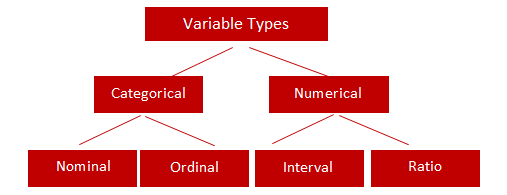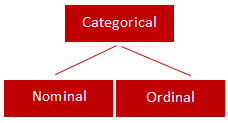In the image shown below, we are showing the different types of variables in statistics.

Qualitative data are often termed categorical data. Data that can be added into categories according to their characteristics. Categorical variables can be classified into two types: Nominal Variables and Ordinal Variables.

A variable that has two or more categories, without any implied ordering.
- Gender - Male, Female
- Marital Status - Unmarried, Married, Divorcee
- State - Texas, New Delhi, Illinois, Michigan
A variable that has two or more categories, with clear ordering.
- Scale - Strongly Disagree, Disagree, Neutral, Agree, Strongly Agree
- Rating - Very low, Low, Medium, Great, Very great
Numeric variables can be classified into two types: Interval variables and Ratio variables.
In statistics, intervals mean the set of values between two numbers. An interval variable is similar to an ordinal variable except that the intervals between the values of the interval variable are equally spaced. In other words, it has order and equal intervals.
- Temperature in Celsius - Temperature of 30°C is higher than 20°C and temperature of 20°C is higher than 10°C. The size of these intervals is the same.
- Dates - The difference between 1st March and 1st April is the same as between 1st May and 1st June.
It is interval data with a natural zero point. When the variable equals 0.0, there is none of that variable.
- Height
- Weight
- Temperature in Kelvin - It is a ratio variable, as 0.0 Kelvin really means 'no temperature'.
- Number of Patients in a Hospital.
Explanation : A weight of zero means no mass. We can also compare weights. For example, someone weighing 80 kilograms is double the weight of someone weighing 40 kilograms.
Ratio variables can be continuous or discrete.
| Discrete Variable | Continuous Variable |
|---|---|
| Values that you cannot divide | Any value within a range |
| Count Data | Measurable Data |
Continuous variables can take on any value within a range. Examples : Height, weight, temperature (in Kelvin) are all continuous variables.
Annual Income is a continuous variable because it can take on any value within a certain range.
Discrete Variables can only take on whole values within a range. It means you can count the possible values. Examples : Number of siblings, number of nurses in a hospital, results of a coin toss are all discrete variables.


so simple.is written in an understandable form
ReplyDeleteA very good start for the beginners to continue their journey till they become master
ReplyDeletevery well crafted for beginners to become master it.
ReplyDeleteWow
ReplyDeleteReally great approach to learn statistics in easy way and understandable format
ReplyDeleteSo a ratio is a subtype of interval data : may you correct the tree chart ?
ReplyDeleteNo
DeleteReally good explanation!
ReplyDeleteEasy to understand
ReplyDeleteGood Explanation
ReplyDeleteGood Explanation & easy to understand
ReplyDeleteWow.Awesome
ReplyDeleteAwesome
ReplyDeleteThank u for good understandable points
ReplyDeleteIt's perfect!
ReplyDeleteSimple and clear!
ReplyDeleteIt's rather confusing that ratio data type is also interval data type with natural zero point. The example given were height and weight. The reason it's confusing is because height and weight are both continuous (as opposed to discrete) data type, meaning they could have infinite number of decimal points, that said, if they are also "interval" data type, what are their intervals ?
ReplyDeleteIn ratio variables, the intervals mean the difference between two values. We can compare height and weight. For example, someone weighing 80 kilograms is double the weight of someone weighing 40 kilograms. Ratio variables can be either continuous or discrete. Weight is a continuous ratio variable.
Delete